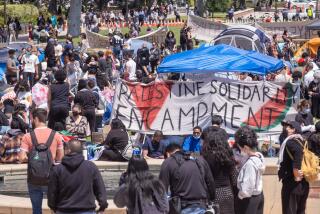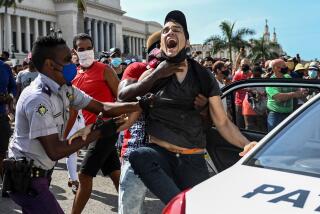Two Decades Later, Mariel Boat Lift Refugees Still Feel Effects of Riot
BARLING, Ark. — “Manuel Fuente was here,” reads one faint message, scraped in Spanish into a barracks wall. And on an opposite wall of Ft. Chaffee, inside a hand-fashioned heart, is this scrawled sentiment: “Iatalina y Jorge.”
Simple human expressions, they are also something far more: a silent, physical reminder of a time of chaos and bloodshed that visited this place two decades ago when 21,000 Cuban refugees rioted and National Guard troops surrounded a U.S. Army post barracks to restore an uneasy calm.
Like the scribbling they left behind, the men who lived in this now-abandoned barracks during the summer of 1980 are more complicated than they first appear. They are roofers and factory workers, blue-collar laborers who came to be in this corner of Arkansas under incredible circumstances.
Floods of refugees crossed the Florida Strait in 1980 during the six-month Mariel Boat Lift, when Fidel Castro temporarily lifted restrictions preventing his people from leaving their Caribbean homeland.
More than 125,000 people left Cuba; among them the “undesirables”--people from the nation’s prisons and insane asylums--but also many law-abiding, mentally healthy “Marielitos” who continue to suffer the stigma associated with the exodus.
One of five refugees eventually landed at Ft. Chaffee in the midst of a political storm further fueled by a backlash from a community that feared them and wanted them sent elsewhere.
As the summer progressed, violence inside and outside Ft. Chaffee escalated. Locals, many armed with rifles, marched through the streets of Barling. Hooded members of the Ku Klux Klan demonstrated outside the front gate.
Most of the Cubans are gone now, save for a few making lives around nearby Ft. Smith. Those who remain say the riot is only a sliver of their history, but it has defined the community’s view of them ever since.
Even the recent influx of Spanish-speakers from Mexico and central America hasn’t helped their adjustment, more than 20 years after the riot. While the refugees and the newcomers share a language, there is no sharing the experience.
“When we look around, we are just ourselves. We can talk to other people, but the only ones who can understand everything we’ve been through are each other,” said Earlton Batles Manley, one of about 15 Mariel refugees still in the area.
The Cubans liken what has happened to a scar that, decades later, hasn’t healed.
“It was a tremendous human saga,” said Jack Moseley, editor of the Times Record newspaper in nearby Ft. Smith. “No one was very high on the Cubans. It was a totally different reaction than to the Vietnamese who were out there in the 1970s.”
Clinton’s Decision Helped Defeat Him
Then-Gov. Bill Clinton agreed with the Carter administration’s decision to house some of the Cuban refugees in Arkansas, a move that later contributed to Clinton’s defeat in his first reelection bid.
Afelino Fuentes Roca, one of the refugees sent to Ft. Chaffee, has remained in the region and recently revisited the old Army post, which was closed in 1995 as part of the nation’s military cutbacks.
Sitting on the front steps of a barracks, he recalled the events in his life that led him here. The memories, he said, are like a movie--too fantastic to be real.
He was asleep in a Cuban prison cell on May 9, 1980, 14 years into a 71-year sentence for theft.
“They knocked on my door and said, ‘You get out of here. You are leaving the country,’ ” said Roca, now a Ft. Smith roofer.
Less than 48 hours later, after crossing a slice of ocean in a small boat, he went from a 14-year diet of mostly bread and water to being served sandwiches and soft drinks in an airplane headed to Arkansas. He patted his stomach with satisfaction and rolled his eyes in amazement while sharing the memory.
When the plane landed, he disembarked into chaos. The anxiety and uncertainty of the refugees was turning to bloodshed.
Roca said many of the Cubans, detained for months at the base, wanted to begin their new lives in freedom, but they weren’t allowed to leave Ft. Chaffee until they found sponsors willing to take them in. That wasn’t easy: Mariel refugees had been labeled criminals.
Jose Salina, another refugee still in the area, said the refugees were antagonized by the Ku Klux Klan and the angry townspeople who demonstrated against them.
“Many of us were taken out of our country against our will. We came here, we didn’t know the language and we didn’t know what our future would be. And you had extremely violent people kept in the same place as honest people,” he said.
In June 1980, the refugees rioted and set several base buildings afire. About 300 escaped and ran through the streets of nearby Barling before being captured. Clinton mobilized the National Guard, and officials from the Carter administration flew down to help.
By the time the last Cubans left the base in February of 1982, law enforcement officials estimated that at least 450 assaults had occurred. Two Cubans died in the attacks on the base.
“The people of Barling and all that area were carrying guns,” said J. Fred Patton, 94, a historian and lifelong Ft. Smith resident. “They were scared to death.”
He said the town divided into two groups--people who sympathized with the Cubans and those angered at their presence. In the end, he said, it was a lesson about patience and tolerance.
“I think we have done a better job of integrating new citizens since,” he said.
But others say the reaction from the town was as much about racism as fear.
“There wasn’t a level of acceptance when the Cubans arrived,” said Billye Carter, who with her husband, Don, sponsored some of the Cubans.
“The first Cubans who came looked white. And then some of the other ones were black,” she said. “You hate to say it, but I think there was a reaction to that.”
Carter worked at the base when the Cubans began arriving and was a member of the Black Community Developers, an organization that tried to help the refugees.
“After the darker-skinned Cubans came, people started getting leery,” he said, “and the sponsorships stopped.”
To this day, the Carters and the Cubans remain close.
“We were 20,000 people surrounded by a barricade, and none of us knew what our destiny would be,” said Manley, a black Cuban who said he was able to survive the experience because of help from black Ft. Smith residents like the Carters.
Tears welled in Roca’s eyes as he told of his flight to freedom. Then he said: If he’d known that 14 years in prison in Cuba would produce 20 years of freedom in the United States, he would repeat his life willingly.
“I would go through it all again,” he said.
More to Read
Sign up for Essential California
The most important California stories and recommendations in your inbox every morning.
You may occasionally receive promotional content from the Los Angeles Times.










